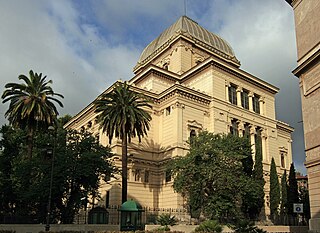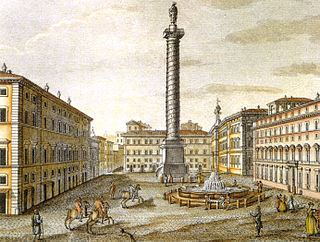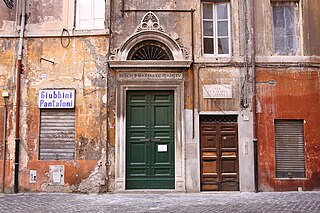
The Roman Ghetto or Ghetto of Rome was a Jewish ghetto established in 1555 in the Rione Sant'Angelo, in Rome, Italy, in the area surrounded by present-day Via del Portico d'Ottavia, Lungotevere dei Cenci, Via del Progresso and Via di Santa Maria del Pianto, close to the River Tiber and the Theatre of Marcellus. With the exception of brief periods under Napoleon from 1808 to 1815 and under the Roman Republics of 1798–99 and 1849, the ghetto of Rome was controlled by the papacy until the capture of Rome in 1870.

Trevi is the 2nd rione of Rome, identified by the initials R. II, located in Municipio I. The origin of its name is not clear, but the most accepted theory is that it comes from the Latin trivium, because there were three streets all leading to the current Piazza dei Crociferi, a square next to the modern Trevi square. Its coat of arms is made of three swords on a red background.

Sant'Eustachio[santeuˈstaːkjo] is the 8th rione of Rome, identified by the initials R. VIII. It is named after the eponymous church and is located within the Municipio I.

Regola is the 7th rione of Rome, Italy, identified by the initials R. VII, and belongs to the Municipio I. The name comes from Arenula, which was the name of the soft sand that the river Tiber left after the floods, and that built strands on the left bank.

Sant'Angelo is the 11th rione of Rome, Italy, located in Municipio I. Often written as rione XI - Sant'Angelo, it has a coat of arms with an angel on a red background, holding a palm branch in its left hand. In another version, the angel holds a sword in its right hand and a scale in its left.

Borgo is the 14th rione of Rome, Italy. It is identified by the initials R. XIV and is included within Municipio I.

Giacomo della Porta (1532–1602) was an Italian architect and sculptor, who worked on many important buildings in Rome, including St. Peter's Basilica. He was born at Porlezza, Lombardy and died in Rome.

Piazza del Popolo is a large urban square in Rome. The name in modern Italian literally means "People's Square", but historically it derives from the poplars after which the church of Santa Maria del Popolo, in the northeast corner of the piazza, takes its name.

Filippo Barigioni (1690–1753) was an Italian sculptor and architect working in the Late Baroque tradition.

The fountain in the Piazza d'Aracoeli is a fountain in Rome (Italy), located at the base of the Capitoline Hill, in the little square with the same name.

The fountain in the Piazza Colonna is a fountain in Rome, Italy, designed by the architect Giacomo Della Porta and constructed by the Fiesole sculptor Rocco Rossi between 1575 and 1577.

The Fontana del Pantheon was commissioned by Pope Gregory XIII and is located in the Piazza della Rotonda, Rome, in front of the Roman Pantheon. It was designed by Giacomo Della Porta in 1575 and sculpted out of marble by Leonardo Sormani.

The Fountain of Neptune is a fountain in Rome, Italy, located at the north end of the Piazza Navona.

The Fontana delle Tartarughe is a fountain of the late Italian Renaissance, located in Piazza Mattei, in the Sant'Angelo district of Rome, Italy. It was built between 1580 and 1588 by the architect Giacomo della Porta and the sculptor Taddeo Landini. The bronze turtles around the upper basin, usually attributed either to Gian Lorenzo Bernini or Andrea Sacchi, were added in either 1658 or 1659 when the fountain was restored.

The Fountain in Piazza Santa Maria in Trastevere is a fountain located in the square in front of the church of Santa Maria in Trastevere, Rome, Italy. It is believed to be the oldest fountain in Rome, dating back, according to some sources, to the 8th century. The present fountain is the work of Donato Bramante, with later additions by Gian Lorenzo Bernini and Carlo Fontana.

The Fountain of the Tritons is a fountain in Rome (Italy), Piazza Bocca della Verità, in front of the basilica of Santa Maria in Cosmedin. This fountain should be distinguished from the similarly named nearby Triton Fountain by Gian Lorenzo Bernini, in the Piazza Barberini, with only a single Triton.

Piazza d'Aracoeli is a square of Rome (Italy), placed at the base of the Capitoline Hill, in the Rione X Campitelli.

Santa Maria del Pianto is a Roman Catholic church in the Rione Regola, with entrances on the South at Piazza delle Cinque Scole/ Via di Santa Maria de' Calderari and on the north on Via di Santa Maria del Pianto. It is presently affiliated with Oblates of the Virgin Mary.

Gillis van den Vliete known in Italy as Egìdio della Riviera was a Flemish sculptor, restorer of ancient sculptures and antique dealer. His active career was spent in Italy, mostly in Rome. He produced both religious and secular sculpture including garden ornaments and tomb monuments. On some large projects he collaborated with other sculptors such as Nicolaes Mostaert, a Flemish sculptor active in Italy at the same time. His works are executed in the Northern Renaissance style which he had been trained in, in his native Flanders, but also intimate the advent of Baroque sculpture.




















